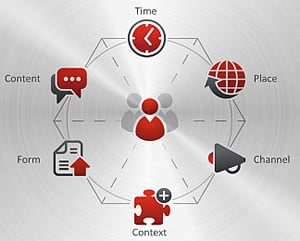
Marc Koch explains the changing customer communication preferences and the impact on the customer communications management (CCM) market.
Marc Koch is the founder of Germany-based legodo, a provider of standard software in the customer communication management (CCM) space. We take a look at highly personalized communication or ‘hyper-personalization’ with Marc: personalized content and communications for the real-time customer.
Can you start by telling us a bit more about legodo?
Marc Koch: legodo is a provider of standard software in the customer communication management (CCM) market space.
Leveraging available data in underlying applications (such as CRM, ERP systems), legodo is capable of generating highly personalized, written communication. In regards to the generation of the “documents” (Document Output for Customer Communications Management or DOCCM) it is important to understand and appreciate three aspects:
- The production can happen interactively (end user can manipulate text) or completely automatically.
- Practically any type of output channel is supported (SMS, Social Media, email, print, fax, website, mobile devices,…).
- The communication is not stand-alone but process-integrated any required activities depending on the business context/process are automatically executed.
DOCCM is Document Output for Customer Communications Management. A Forrester report written by business agility expert Craig Le Clair, explored the capabilities of a sample of vendors and products in a very specific sector of the Document Automation space (more below).
Information management at work: acting upon customer information

The right information at the right time via the right channel is the credo of customer-centric communications in an age of content and context. It has also always been the credo of enterprise content management and enterprise information management. I noticed you use it on your website and saw the graphic. How do you see the link between content management and multi-channel communications?
Marc Koch: Many companies have invested a great deal of efforts and money in putting in place CRM and Business Intelligence systems to obtain detailed information about their customers.
But when it comes to use that information in the communication process this knowledge is often not utilized to provide a customer with a personal experience. Also, the (re-)integration of that communication into the underlying applications and processes that should provide a 360 degree view of the customer is still challenging as different departments use different tools, data sets and content.
How would you define intelligent information management? How do you see it from the customer and communications perspective? And from the content management perspective?
Marc Koch: from our perspective, intelligent information management is the ability to use available information in real-time to personalize written communication across any channel.
As a customer I would expect to receive only information that is relevant to myself and my current business context. This information should be provided via my preferred channel.
From the content management perspective the vision of CCM is to have one single platform for all written communication within an organization. Today, content for customer communication (templates, text blocks, etc.) is typically distributed in various different applications. The consolidation into one single platform would reduce redundancies and maintenance costs while improving quality and customer experience.
What is CCM? Gartner defines customer communications management (CCM) “as the strategy to improve the creation, delivery, storage and retrieval of outbound communications, including those for marketing, new product introductions, renewal notifications, claims correspondence and documentation, and bill and payment notifications”.
The shifts in communication preferences: immediacy, quality, pro-activity
The customer journey has changed. The shift in the power balance regarding communication preferences, customer touchpoints and channels is one of the many reasons why today there is – among others – so much focus on the role of relevant and timely content in a customer interaction context. Can you explain some of the evolutions you see happening in what you call the customer communication journey?
Marc Koch: the power balance regarding communication preferences has indeed shifted towards the customer. Here are some of the changes that we are experiencing in our client base:
- With the dramatic increase in mobile communication the customer expects immediate responses to inquiries on their chosen channel.
- Customers expect a much higher quality of service and faster resolution times. In other words, they expect to receive less but higher quality communication.
- As companies gather a significant amount of very personal data, we also see a trend towards to pro-active customer notifications, providing relevant information.
Your business is mainly about customer communications in a context of personalization and multi-channel journeys. I wonder what your views are regarding the market evolutions in the ECM market and content management in general? How is the market moving from a more or less IT tradition to a more business-oriented approach now that IT is increasingly expected to focus on business?
Marc Koch: we believe in “Business Empowerment”. We think, that the changes necessary for a positive customer communication experience are most likely to be initiated by business process owners. On the other hand a successful CCM initiative cannot do without a deep integration into business processes and the underlying IT systems.
However, as of today this situation in real life customer projects is often burdened by conflicts. Sometimes there are setups where one would find a “Vice President Customer Experience Management”, a “Head of Customer Service” or a similar business function clearly looking for ways to improve customer communication. When it comes to integration, centralization of content and cross channel management suddenly IT has a powerful position in the discussion. The interest of IT is sometimes quite contrarious to the targets business is pursuing.
If the organization cannot overcome this conflict, the outcome of the CCM initiative will be mediocre in the best case. Only the organizations that manage to solve these issues have the chance to deliver a consistent and top of the shelf customer communication.
As companies gather a significant amount of very personal data, we see a trend towards to pro-active customer notifications, providing relevant information (Marc Koch).
Hyper-personalization and content personalization
Personalization is becoming more and more important in marketing with scenario-based and data-driven communications combining all possible customer data and signals. You even talk about hyper-personalization. Can you explain a bit more? What role does fast data play? How far do you go in personalization, knowing that at a certain point the cost can trump the benefits?
Marc Koch: hyper-personalization signifies the highest level of personalization. In other words, every single piece of correspondence that goes out to the customer is completely unique. So companies are faced with the challenge of automation vs. personalization of communication.
To enable hyper-personalization, real-time access to customer data and its usage in the right context is critical. This implies that there needs to be a shift from IT-centric towards Business-centric maintenance of content and business logic. Today, technologies exist to resolve this dilemma so that hyper-personalization is feasible in any scenario.
Finally, another question on content personalization. It happens in marketing automation systems. It can be done using some web content management systems. How do you see the market evolving in this regard. Where will content personalization happen? How will we connect the dots between the customer experience on one hand and content management on the other?
Marc Koch: content personalization happens in various applications and usually requires a high degree of IT support. legodo believes that it is important to empower the business to self-sufficiently manage all aspects of content creation and maintenance. At companies that are striving for an integrated communication platform, we have noticed that these companies are e.g. establishing cross-functional “authoring” teams responsible for delivering the right content.
So, for organizations where customer experience is of high importance, managing customer communication is not anymore a topic on the departmental level but on the agenda of the CxO’s.
To enable hyper-personalization, real-time access to customer data and its usage in the right context is critical. This implies that there needs to be a shift from IT-centric towards Business-centric maintenance of content and business logic.
DOCCM: solutions for customer communications management
The above mentioned Forrester Research report defined DOCCM as “Software used to compose, format, personalize, and distribute content to support physical and electronic customer communications and improve the customer experience” and suggested that document output needs can be divided into structured, interactive, and on-demand processes defined as follows:
- “Structured Output runs in batches, often in large volumes. Structured output is scheduled, consistently formatted, and sent as part of a service relationship (much like phone bills and brokerage statements); it also includes batch digital or offset print runs”.
- “Interactive Output marries custom content or data with preset structure. Interactive output requires the human touch, often matching variable customer data with structured forms or templates, providing a more individualized output; examples include customer correspondence and negotiated documents like group insurance policies or derivative and margin contracts”.
- “On-Demand Output is triggered by multichannel requests. Events from the Web, fax, phone, email, transactional systems, or enterprise applications drive on-demand output, and on-demand events may also be initiated by a human being via a keystroke, as in call center correspondence”.

